The host is relatively unpretentious. She survives in the most shaded areas of the garden, does not require frequent watering and constant transplants. However, the most difficult time for this plant is wintering. The period of awakening and the condition of the bush in the spring depend on how correct the treatment was. Pruning varieties, top dressing, pest protection - all these are important stages of caring for the host in the fall and preparing it for the upcoming winter.
Content
Key events
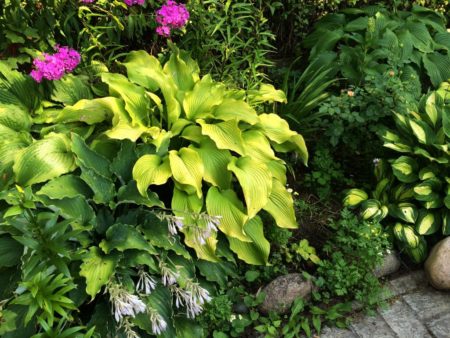 Although the bush is perennial, it survives even in cold and not too snowy winters, damage is inevitable if at least minimal treatment is not carried out. Trimming the entire host or not is a moot point for most gardeners; however, this is far from the only mandatory action that needs to be planned.
Although the bush is perennial, it survives even in cold and not too snowy winters, damage is inevitable if at least minimal treatment is not carried out. Trimming the entire host or not is a moot point for most gardeners; however, this is far from the only mandatory action that needs to be planned.
Pruning
By pruning is understood either the removal of peduncles, or the cut of all leaves. The first must be done at the end of summer. A plant is a decorative-deciduous plant, it does not produce beautiful lush buds, its flowering is exceptionally practical, and is aimed at scattering seeds. To get lush foliage, flowers are removed immediately after the appearance of the first yellow patches or a few days after their appearance. If, nevertheless, they remained until the fall, they must be cut off before winter.
Gardeners who advocate pruning refer to the fact that this way the plant manages to accumulate more juices in the roots, due to which they become more resilient, easier to survive overwintering. In the spring, the bush is no longer burdened by old leaves, does not waste time dumping them, and immediately begins to grow new ones. In addition, last year’s overgrowth can cause infection with various infections, can attract pests, it will negatively affect young herbs, ruin the appearance of hosts.
Opponents of pruning in turn remind that leaves under a layer of snow will turn into compost. They will be a good mulch for the soil, they will bring in the first nutrients that the plant needs so much in the spring. Importantly, untimely pruning of any hosts can be very dangerous. It is important that all sections have time to close before the onset of the first cold weather. If this procedure is not carried out at all, the risk of freezing is minimal.
Professional breeders believe that preparing hosts for the upcoming winter and shelter may be limited to partial pruning. This is the safest option, although full processing is acceptable. This means that you can remove only sluggish and yellow leaves, peduncles and stems with suspected disease, leave the rest. It is impossible to completely abandon this procedure, this can lead to the death of the bush.
Shelter
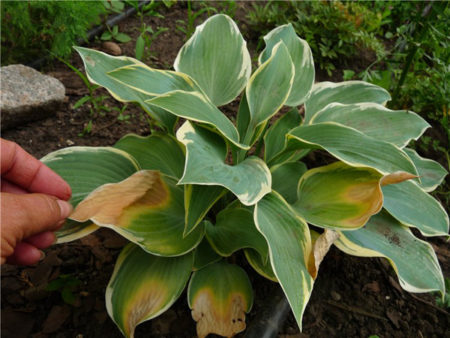 A host of any sort must be covered in autumn if temperatures fall below minus 10 degrees. This procedure is aimed at the formation of increased snow cover, warming itself is not required as such. You can refuse to shelter in the southern regions.
A host of any sort must be covered in autumn if temperatures fall below minus 10 degrees. This procedure is aimed at the formation of increased snow cover, warming itself is not required as such. You can refuse to shelter in the southern regions.
It is important to choose the right material. The bush even remains “alive” even under the snow, so roofing material, a plastic film will not work: moisture will accumulate under them, air flow will be shut off, the bush will rot. You can use:
- agrofibre;
- burlap;
- lapnik.
First thoroughly mulch the soil, then cover the bush completely, leaving a small "skirt" on the ground. Some gardeners increase cover layers in the area where the root system is located under the soil.If the bush is sprawling, additionally the materials are pressed with thick branches, and the “crown” is pulled together with a bundle or twine. This is a reliable protection against wind.
In the northern regions, a multilayer shelter is needed. The host is prepared for a long winter cold, covering the roots with a layer of peat, covering with spruce spruce branches, protecting geo-fabric with large pores from above. After the first snowfall in any region, you need to fill the bush yourself. Thus, even with a small amount of rainfall, the host will be protected.
Terms of preparation
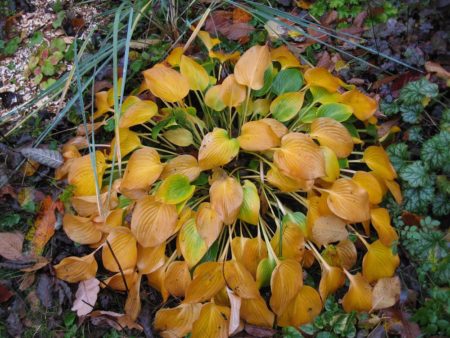 Landing and caring for the host in the open ground is the main method for most regions. Regardless of the region, preparation times are calculated equally. After pruning, top dressing and the last watering, 2-3 weeks should pass before the first frost. If all the work is not possible to complete, it is better to abandon the removal of leaves and restrict only pruning peduncles.
Landing and caring for the host in the open ground is the main method for most regions. Regardless of the region, preparation times are calculated equally. After pruning, top dressing and the last watering, 2-3 weeks should pass before the first frost. If all the work is not possible to complete, it is better to abandon the removal of leaves and restrict only pruning peduncles.
In the Moscow Region and Central Russia, there is no need for capital shelter of bushes. You can limit yourself to thorough mulching and trimming. You can carry out these works from mid-September to mid-October. In the Volga region, special attention should be paid to protection from the wind, since large bushes may not withstand such a load.
In the climate of the Urals, it is necessary to take into account forecasts for each specific year. As a rule, snow cover appears here immediately, the first frost begins in late October. Therefore, the preparation of hosts must begin in mid-September and finish no later than the first days of October. Particular attention should be paid to mulching, the shelter can be single-layer. If the forecast is expected to have a little snowy winter, it is better to make several layers of protection and cover additionally with snow.
Contrary to popular belief, hosts feel great in Siberia in the winter. A thick layer of snow becomes their best defense. In areas closer to the Far East, rainfall is less and cold winds are stronger, which should be considered when preparing. The best option for shelter is the lapnik, which is folded after thorough mulching. If severe frosts are expected, additionally the bush can be thrown with soil mixed with straw. In areas with severe wind load, additional use of agrofibre is required. Preparation should be completed by mid-September, so that the first frost does not spoil the root system.
Softer winters are in the Leningrad region, however, the snow here often does not linger, periodically melts until January. Therefore, it is important to thoroughly mulch the roots, cover and tie up the bush, especially if it is large enough and adult. All work is carried out until mid-October, it is permissible to shelter the host in early November, however, pruning must be completed by the 15th of October.
Common mistakes
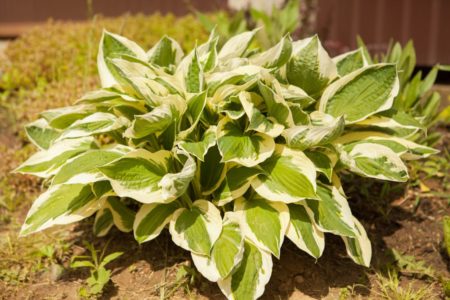 Although hosts are considered one of the most unpretentious, even small mistakes in care, especially in the fall, can significantly slow down the development of the bush and its growth. Most often, the root system dies precisely because of frost, in second place is the impact of pests that seek food in harsh climates. Therefore, avoid:
Although hosts are considered one of the most unpretentious, even small mistakes in care, especially in the fall, can significantly slow down the development of the bush and its growth. Most often, the root system dies precisely because of frost, in second place is the impact of pests that seek food in harsh climates. Therefore, avoid:
- untimely transfers;
- late pruning;
- improper feeding;
- overdrying soil;
- greenhouse effect.
It is undesirable to transplant a shrub after the month of August. During this time, the roots will not have time to strengthen, they will be weakened, so the wintering is unlikely to go well. The ideal time to move hosts is spring. Late pruning is also undesirable, it is better to completely abandon this procedure.
 You may be interested in:
You may be interested in:After September, it is not recommended to use nitrogen fertilizers. The host should at the end of summer go into a kind of "hibernation", accumulate juices in the root system, while nitrogen will stimulate the growth of new leaves. In the cold, they will not survive, and the entire bush will be weakened. Sufficient moisture is the main factor that will affect the state of the host’s roots. If the soil is dried, wintering will be very difficult, especially for young plantings.
You can kill the whole bush by choosing the wrong covering material. The ruberoid seems to be a reliable protection because of its thickness, while the film does not pass gusts of cold wind and is inexpensive. However, both lead to the creation of a greenhouse effect. Moisture accumulates inside, after a drop they can freeze, damaging the ground part of the host. Excess moisture will cause mold and mildew.
Preliminary processing
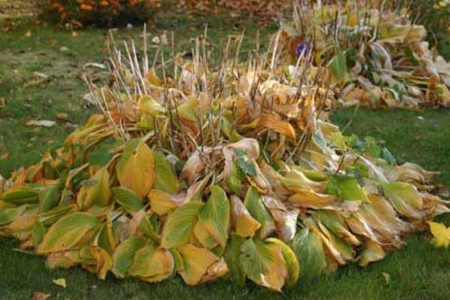 Following the rules on how to prepare your favorite hosts for the winter, you can achieve a quick spring awakening. Particular attention should be paid to top dressing, mulching and final watering. In terms of timing, you need to focus on annual forecasts and the average climate, but the general rules for preprocessing are universal.
Following the rules on how to prepare your favorite hosts for the winter, you can achieve a quick spring awakening. Particular attention should be paid to top dressing, mulching and final watering. In terms of timing, you need to focus on annual forecasts and the average climate, but the general rules for preprocessing are universal.
Hosts respond best to complex supplements in the fall, while all stimulant medications need to be ruled out. It is optimal to apply fertilizer immediately after irrigation or rain in moist soil. In autumn, only the root method of feeding is left, foliar is no longer required, since the leaves do not need to develop during this period. You can use superphosphates and potassium concentrates, 30-40 grams per 1 square meter of soil, dissolve according to the instructions.
In winter, caterpillars and bugs pose a special danger to the bush. Slugs and snails during this period are practically inactive. You can protect yourself from all these pests using simple folk remedies. For example, before shelter, sprinkle the entire area under the crown of leaves with crushed egg shells. In spring, this layer will be a source of calcium beneficial for hosts. With the awakening of the bush, one of the most dangerous pests, nematodes, is activated. It is impossible to destroy them, so even before shelter you should check the leaves. Finely chop one hosta, fold it into a glass, add water and leave it in the light for a couple of hours. After carefully consider: if there are small white worms in the water, you need to dig up the bush urgently so that in spring it does not infect the rest of the plantings.
Mulching hosts before wintering is a must. A mixture of peat, sawdust and dry humus in equal proportions is well suited for this. As a result, you need to get a dense layer with a thickness of at least 1 centimeter. The stronger the frosts and the less snow, the more mulch is needed.If there are a lot of slugs and snails in the area, you need to add tobacco dust and phytosporin to the mixture. The first will protect against pests, the second from fungi spread by these creatures. In the spring, mulch will become a full-fledged fertilizer.
Useful Tips
When deciding whether to host hosts of any sort for the winter, how to handle them, you should be guided by simple tips. Trimming is carried out only with a sharp secateurs. It is unacceptable to manually pick off even yellow leaves and dry peduncles, use blunt knives or scissors. Torn edges do not drag out for a long time, attracting pests. The bush will spend a lot of energy on their healing, which will weaken the host before the winter.
 You may be interested in:
You may be interested in:Mulch is most often left under the bush after winter, but if the warming is weak, the spring is late, it is better to remove this layer. So, the soil warms up, the bush will grow, faster pick up juices. This applies both to variegated varieties and to more whimsical blue species.
Bushes are not afraid of the weight of snow, so during the winter you can throw it more than once in a shelter. The bigger the hat, the better. Although the host is not afraid of frost, she still loves warmth much more.
Proper preparation for the winter is important for any sort of hosta. Compliance with simple rules will save even young bushes, the grower will be able to see fast annual growth. Regardless of the type of crop, you must pay attention to proper feeding, abundant watering. These procedures are not time-consuming, but you need to plan them for a certain time, depending on the region of landing.




 10 beautiful annuals that bloom all summer
10 beautiful annuals that bloom all summer Sow in the ground, without seedlings: 10 beautiful and unpretentious flowers
Sow in the ground, without seedlings: 10 beautiful and unpretentious flowers Platicodon planting and outdoor care
Platicodon planting and outdoor care Hosta - planting and care in the open ground in the Urals
Hosta - planting and care in the open ground in the Urals